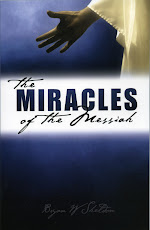The Sign for the Forerunner of the Messiah
Before looking at the miracles (signs) in John’s
gospel, it is appropriate to pause for a moment and look at the sign from
heaven that identified Jesus as the Son of God. Before Jesus started His public
ministry, John the Baptist had a remarkable experience. He spoke of it. “I saw
the Spirit descending from heaven like a dove, and He remained upon Him. I did
not know Him, but He who sent me to baptize with water said to me, Upon whom
you see the Spirit descending, and remaining on Him, this is He who baptizes
with the Holy Spirit. And I have seen and testified that this is the Son of
God.”[1] Here then is the first sign of deity. At the
baptism of the Messiah, the invisible Spirit of God took physical form as a
dove and rested upon Him as a sign.
We can better understand the implications of this
sign when we consider it in conjunction with another event. The Temple authorities asked Jesus for a sign when He first
cleansed the Temple. Having driven out the mercenary influences
from the Temple
area, they wanted Jesus to justify His actions, so they asked Him: “What sign
do You show to us, since You do these things?”[2] He replied: “Destroy this temple, and in
three days I will raise it up.”[3] John explained that He was speaking of His
body not the Jewish second temple. Here Jesus
is already intimating the sign that will occupy our attention later, that of
the prophet Jonah: “for just as Jonah was three days and three nights in the
belly of the sea monster, so will the Son of Man be three days and three nights
in the heart of the earth.”[4] But our immediate concern is the reference to
His body as the Temple.
The Temple
of Solomon (as also the
Tabernacle) had certain things that signified and authorised it as the place where
man could meet with God. They included:
(i)
the divine presence/the divine glory
(ii) the instruments of divine guidance, the Urim and
Thummim,
(iii) the anointing oil,
(iv)
the ark with the mercy seat and the cherubim.
These were lacking in Herod’s Temple.
When the destruction of Solomon’s temple drew near, the divine presence
went up from the Propitiatory[5]
and never returned. The ark with the
mercy seat and cherubim was lost; as was the recipe for the anointing oil. The oracle
by Urim and Thummim was never restored.
The Talmudists said, “Things are not asked or inquired after now (by
Urim and Thummim) by the High Priest, because he does not speak by the Holy Spirit,
nor does there any divine afflatus breathe on him”.
Its association with the name of Herod further
degraded the Temple. The Jews object: “It is not permitted to
anyone to demolish one synagogue, till he has built another”. Therefore, it was much more heinous to
demolish the Temple; but Herod ignored such
concerns and demolished the Temple
before rebuilding it.
The sign to the Baptist and the statement of the Messiah
when taken together, declare that the building, (i) which bore the unholy name
of Herod, and (ii) which was governed by a band of thieves, and (iii) was home
to those who opposed God’s true Messiah, could not be the true Temple of
God.
On the other hand,
(i) Jesus the Messiah, was graced with the divine presence
as the Bat Kohls[6] testify,
and although for the most part the divine glory was veiled there was a night
when a mountain top was lit up by a light brighter than the noon-day sun.[7]
(ii) Because He had access to the divine presence, He had
divine guidance better than that which was available through the use of the
Urim and Thummim.
(iii) Furthermore, His title Messiah, which means ‘Anointed’,
required Him to be anointed to fulfil His office. This anointing took place on the bank of Jordan
when the Spirit of God descended and rested upon Him.[8] Jesus would also be the One to pour out the
Spirit at the Feast of Pentecost after His ascension.[9]
(iv) Jesus Messiah is also our propitiatory. ‘’Tw ἱλαστήριον’ (hilastērion) refers to the ‘mercy seat’ in the Sanctuary[10]. A similar word is used of the Messiah. John the Apostle wrote, “Jesus Christ
the righteous … is the propitiation (‘ἱλασμός’ (hilasmos)) for our sins,
and not for ours only but also for the whole world.”[11] And again, “In this is love, not that we
loved God, but that He loved us and sent His Son to be the propitiation (‘ἱλασμός’ (hilasmos)).for our sins.”[12] He is our propitiatory. Not only so, but the mercy seat was protected
by angelic guardians. So also the
Messiah, especially at those times when He was most vulnerable to attacks from
the Evil One. [13]
In other words, the real Temple of God, (where God can
truly meet with man), which has the Shekinah Glory, the Holy Spirit, the
Propitiatory, the oracle of the Urim and Thummin, the protecting cherubim and
the anointing oil, is the body of Christ, identified to the Baptist by the
Father.
[1] John
1.32-34
[2] John
2.18
[3] John
2.19
[4] Matt.12.40
[5]
Ezek.10.4
[6]
Matt.3.17; 17.5,6; Mark 1.11; John 12.28
[7]
Matt.17.2
[8]
Matt.3.16
[9] Acts
2.33
[10] Heb.9.5
[11] 1 John
2.2
[12] 1 John
4.10
[13]
Matt.1.24;2.13;19; 4.11; 26.53; Mark 1.13; Luke 22.43




